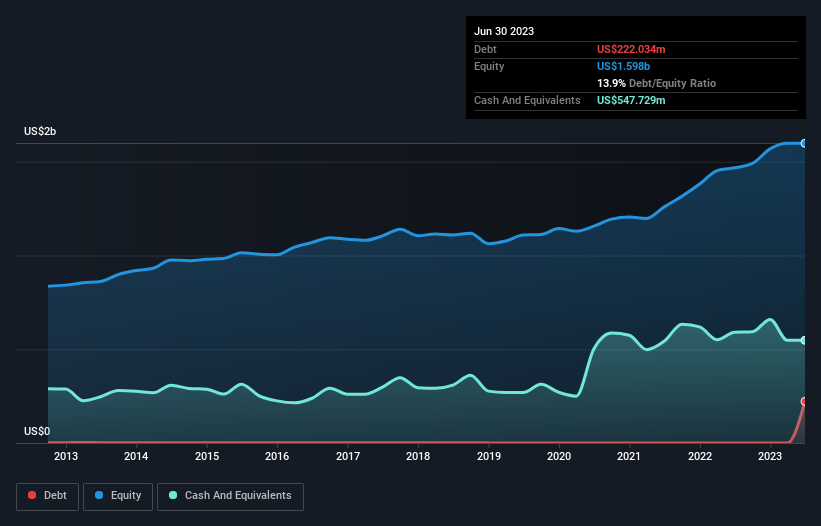- United States
- /
- Professional Services
- /
- NYSE:RHI
We Think Robert Half (NYSE:RHI) Can Stay On Top Of Its Debt

David Iben put it well when he said, 'Volatility is not a risk we care about. What we care about is avoiding the permanent loss of capital.' So it seems the smart money knows that debt - which is usually involved in bankruptcies - is a very important factor, when you assess how risky a company is. As with many other companies Robert Half Inc. (NYSE:RHI) makes use of debt. But is this debt a concern to shareholders?
What Risk Does Debt Bring?
Debt is a tool to help businesses grow, but if a business is incapable of paying off its lenders, then it exists at their mercy. Ultimately, if the company can't fulfill its legal obligations to repay debt, shareholders could walk away with nothing. However, a more usual (but still expensive) situation is where a company must dilute shareholders at a cheap share price simply to get debt under control. Of course, the upside of debt is that it often represents cheap capital, especially when it replaces dilution in a company with the ability to reinvest at high rates of return. The first step when considering a company's debt levels is to consider its cash and debt together.
See our latest analysis for Robert Half
How Much Debt Does Robert Half Carry?
You can click the graphic below for the historical numbers, but it shows that as of March 2023 Robert Half had US$222.0m of debt, an increase on none, over one year. But on the other hand it also has US$547.7m in cash, leading to a US$325.7m net cash position.

How Healthy Is Robert Half's Balance Sheet?
According to the last reported balance sheet, Robert Half had liabilities of US$1.15b due within 12 months, and liabilities of US$165.3m due beyond 12 months. Offsetting these obligations, it had cash of US$547.7m as well as receivables valued at US$1.01b due within 12 months. So it can boast US$243.3m more liquid assets than total liabilities.
This short term liquidity is a sign that Robert Half could probably pay off its debt with ease, as its balance sheet is far from stretched. Succinctly put, Robert Half boasts net cash, so it's fair to say it does not have a heavy debt load!
It is just as well that Robert Half's load is not too heavy, because its EBIT was down 33% over the last year. Falling earnings (if the trend continues) could eventually make even modest debt quite risky. When analysing debt levels, the balance sheet is the obvious place to start. But ultimately the future profitability of the business will decide if Robert Half can strengthen its balance sheet over time. So if you're focused on the future you can check out this free report showing analyst profit forecasts.
But our final consideration is also important, because a company cannot pay debt with paper profits; it needs cold hard cash. Robert Half may have net cash on the balance sheet, but it is still interesting to look at how well the business converts its earnings before interest and tax (EBIT) to free cash flow, because that will influence both its need for, and its capacity to manage debt. Over the most recent three years, Robert Half recorded free cash flow worth 76% of its EBIT, which is around normal, given free cash flow excludes interest and tax. This cold hard cash means it can reduce its debt when it wants to.
Summing Up
While we empathize with investors who find debt concerning, you should keep in mind that Robert Half has net cash of US$325.7m, as well as more liquid assets than liabilities. The cherry on top was that in converted 76% of that EBIT to free cash flow, bringing in US$625m. So we are not troubled with Robert Half's debt use. We'd be motivated to research the stock further if we found out that Robert Half insiders have bought shares recently. If you would too, then you're in luck, since today we're sharing our list of reported insider transactions for free.
When all is said and done, sometimes its easier to focus on companies that don't even need debt. Readers can access a list of growth stocks with zero net debt 100% free, right now.
New: AI Stock Screener & Alerts
Our new AI Stock Screener scans the market every day to uncover opportunities.
• Dividend Powerhouses (3%+ Yield)
• Undervalued Small Caps with Insider Buying
• High growth Tech and AI Companies
Or build your own from over 50 metrics.
Have feedback on this article? Concerned about the content? Get in touch with us directly. Alternatively, email editorial-team (at) simplywallst.com.
This article by Simply Wall St is general in nature. We provide commentary based on historical data and analyst forecasts only using an unbiased methodology and our articles are not intended to be financial advice. It does not constitute a recommendation to buy or sell any stock, and does not take account of your objectives, or your financial situation. We aim to bring you long-term focused analysis driven by fundamental data. Note that our analysis may not factor in the latest price-sensitive company announcements or qualitative material. Simply Wall St has no position in any stocks mentioned.
About NYSE:RHI
Robert Half
Provides talent solutions and business consulting services in North America, South America, Europe, Asia, and Australia.
Flawless balance sheet established dividend payer.


